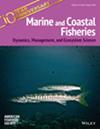Stock identification and age prediction of Red Mullet Mullus barbatus in the western Black Sea (Türkiye) as inferred from otolith shape descriptors
Abstract
Objective
In this study, we applied shape analysis to differentiate two Red Mullet Mullus barbatus stocks in the western Black Sea and assessed the generalized linear model (GLM) for age prediction based on otolith dimensions and weight.
Methods
Sagittal otoliths from 259 fish were collected by commercial bottom trawl vessels in İğneada and Şile, Türkiye, between October 2017 and April 2018. Otolith shape was described using wavelet transformation (contour shape) along with four morphometric characteristics (otolith length, area, width, and perimeter) and six shape indices (circularity, rectangularity, form factor, roundness, ellipticity, and aspect ratio) to reveal differences between the two regions. Shape indices were explored using multivariate statistical methods, including multivariate analysis of variance (MANOVA) and canonical discriminant analysis (CDA). Canonical analysis of principal coordinates (CAP) provided an overview of the differentiation in the otolith outline shape between the two stocks by using the wavelet coefficients. The GLMs predicted age using otolith size parameters, shape indices, and otolith weight.
Result
The MANOVA showed no significant differences between sexes but notable differences between right and left otoliths. The CDA achieved a discrimination rate of 65.7% for age 1 and 64.8% for age 3, indicating distinct local populations. The otolith contours varied between Red Mullet sampled in the two regions, with CAP achieving an overall accuracy of 67.1% for both regions, 68.12% accuracy for İğneada, and 66.20% accuracy for Şile. The GLMs identified otolith length, weight, width, and perimeter and fish sex as key factors, with otolith length being the most significant predictor for age estimation.
Conclusion
The close alignment of observed and estimated ages highlights the potential for using otolith length in age estimation.


 求助内容:
求助内容: 应助结果提醒方式:
应助结果提醒方式:


